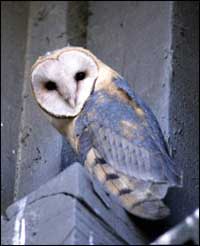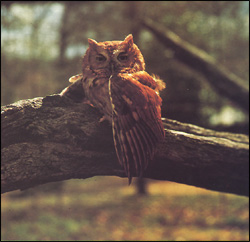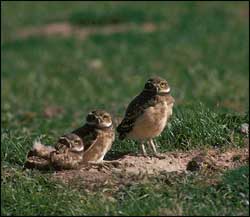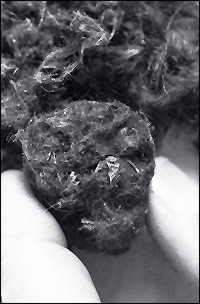Owls

The barn owl's white, heart-shaped face, hunched back, and deep-set black eyes give it an almost ghostly look.
Almost everything about the owl is unusual and interesting. Take time to learn more about it and you will probably agree that this feathered mousetrap is beneficial to have in Texas.
Owls are birds that hunt primarily during crepuscular (twilight) and nocturnal (nighttime) hours, although some species are diurnal (daytime). They belong to a group of birds called raptors, or birds of prey. Nature has well equipped these birds for their particular role in life: natural rodent control. An owl’s whole body is designed to make it an efficient and deadly hunter.
Feet and Beak
The meaning of the word raptor is to “seize, grab, or snatch” or “having tearing claws on the hind legs” which highlights the owl’s first of many adaptations. Owls have claws called talons. These talons are long, sharp, and proportionally thicker than those of other birds, giving them greater strength to pierce prey’s hide or skin. A raptor’s talons must be strong enough to hold struggling prey until it dies, or until the bird can further process its meal with its beak. Once the prey has died, owls’ talons act as a fork to hold their food as they tear it apart using their beak.
All owls have a short, curved, downward-facing beak that is hooked at the end of the top bill. It is designed specifically for gripping and tearing prey. The crushing power of the bill is usually used to kill prey once captured. The upper edge of the lower bill and the lower edge of the upper bill taper to a sharp edge, and overlap in a scissor-like fashion, enabling it to cut through the tissue of the prey. The beak is curved downwards in order to keep the owl’s field of vision clear.

Screech owls may display either a rufous (reddish or rusty brown) or a gray color phase.
Eyesight
Another advantage nature has given the owl is excellent eyesight. An owl’s eye is probably the most efficient organ of vision of any animal. It has a visual sensitivity at least 35 times greater than ours, and possibly as much as 100 times greater. But the owl still cannot see in absolute darkness. Luckily, total darkness, except in deep cave systems, is very rare in nature. On a moonless, cloudy night, which appears to be pitch black to us, the level of illumination rarely drops below .004 foot candles. Studies have shown that the Long-eared, Tawny, and Barn Owls can see their prey from six feet away with as little as .00000073 foot candles of illumination.
Additionally, an owl’s eyesight is binocular, providing it with a single field of three-dimensional vision similar to that enjoyed by humans. Although the owl’s eyeballs are not capable of rotary movement as ours are, the bird overcomes this drawback by having an extremely flexible neck, which enables it to rotate its entire head at least 180 degrees and possibly as much as 270 degrees. This wide range of flexibility in its neck is made possible by the 14 bones in its neck, compared to the seven neck bones humans have.
Hearing
Exceptionally keen hearing completes the owl’s nocturnal design. Some people have the mistaken idea that the tufts of feathers located on the tops of some owls’ heads are ears. These "ear tufts" have nothing to do with the ears or the owl’s hearing. They are merely elongated head feathers that can be erected or depressed at will, perhaps to communicate attack, withdrawal, or some other type of owl body language. They also aid the bird in its camouflage efforts. As the owl sits motionless in its alert posture, it looks like a broken upright tree stub, an illusion that is enhanced by the ear tufts.

Small burrowing owls like to take over the burrows of other animals.
Protruding external ears, which are so common to mammals, are not found in the bird world. That type of ear would cause air resistance when the bird was in flight. The owl’s actual ears are concealed behind the edges of its facial disk. These large ear openings look like concave dishes. By erecting or depressing the plumage (feathers) in front of or behind the ear openings and the asymmetrical placement of the ear holes (one ear hole is higher on the skull than the other), the owl is able to better localize the source of sounds coming from different directions.
In addition to being efficient receivers of sound, the owl’s ears are especially tuned to high-frequency sounds, such as those made by squeaky-voiced rodents. Noises caused as the rodents scurry across dried vegetation, sticks, and other debris also contain a great number of high-frequency sounds that give the owl a clue to the whereabouts of its prey. Studies of Barn Owls have shown that this bird’s excellent hearing enables it to catch living prey in absolute darkness if a rodent squeaks or leaf-rustling gives away its location.
Feathers and Wings
Owls achieve almost noiseless flight and can swoop down on their prey unheard. Two factors work together to accomplish this. First, large wings and a light body enable the owl to support itself easily and quietly in flight. A heavy-bodied bird requires hard-working wings that tend to be noisy. If you have ever heard a startled quail take flight, you have some idea of the noise some birds’ wings can make. Second, most owls have comb-like serrations on the leading edge of wing feathers that break up the turbulent air that typically creates a swooshing sound. Those smaller streams of air are further dampened by a velvety texture unique to owl feathers and by a soft fringe on a wing’s trailing edge. These structures together streamline the air flow and absorb the sound produced by the owl’s beating wings. Owls also have whisker-like feathers that cover the beak area and they have feathers covering their feet all the way to the talons. This is yet another adaptation owls have to be more silent flyers. However, some, such as the pigmy owls, have hard plumage and their unmuffled wings are not noiseless. Since pigmy owls pounce on their prey from vantage points during the early morning and late afternoon, they do not need the silent flight required by the nocturnal species.

Owl pellets contain the indigestible remains of animals swallowed whole or in large pieces the night before.
Diet
Although rodents make up a large percentage of the owl's diet, they are not the only item on the menu. These efficient predators also eat insects, earthworms, fish, crayfish, amphibians, other birds, and small animals. Food studies of owls can be quite accurate because the bird leaves an involuntary record of what it has eaten in the form of an owl pellet. Although an owl sometimes crushes the skull of a mouse or plucks the long wing and tail feathers from a bird, it swallows its prey whole when possible. Larger animals are torn into pieces that can be gulped down. Bones, feathers, fur, and entrails are all swallowed. The nourishing parts are digested and the indigestible parts are compressed into a pellet that is coughed up by the owl. Owl pellets have proven quite valuable to professionals studying the relationship between predators and prey. There can be no doubt as to which prey species are being eaten by owls. Fossilized pellets also have provided us with one of the few true records of what was actually eaten by animals long dead. If you happen to come across an owl pellet, you might want to do a bit of detective work on your own to determine what that particular bird ate. The best way to find out what the pellet contains is to soften it in water and then carefully take it apart. You might even want to examine the contents under a magnifying glass or microscope.Become a Steward for Owls
Here are some actions to take to protect owls:
- Use traps rather than poisons when controlling rodents and reduce the use of insect pesticides. Owls are at the top of the food chain and can suffer poisoning from pesticides they consume from poisoned prey.
- Minimize the use of outdoor decorations and take them down right after the holiday.
- Reduce unnecessary lighting at night in and around your home and yard
- Make fences more visible and less hazardous; take down sporting nets after each use.
- Leave dead trees, an old barn or shed available for nesting or roosting owls.
- Create a space by building a nest box. (will be used as a link… https://www.dnr.illinois.gov/publications/documents/00000211.pdf)
- Drive slow and stay alert for flying owls or roadside birds at night.
- Follow all appropriate birding ethics when viewing or photographing owls.
- Make your yard an owl-friendly habitat to provide them a safe space.
Owl Species Found in Texas
- Barn Owl
- Flammulated Owl
- Western Screech-Owl
- Eastern Screech-Owl
- Great Horned Owl
- Ferruginous Pygmy-Owl
- Elf Owl
- Burrowing Owl
- Barred Owl
- Long-eared Owl
- Short-eared Owl